Keywords
Bartail flathead, Population biology, Assessment, Persian Gulf
Öz: Kuzey Bat? Basra Körfezinde Platycephalus indicus Linnaeus, 1758’ in stok de?erlendirmesi
Platycephalus indicus türü di?i ve erkek bireylerinin boy frekans verilerinden hesaplanan Von Bertalanffy büyüme e?itli?i parametreleri s?ras?yla k = 0,5 y?l−1, L∞ = 62,16 cm (Çatal boy), to=−0.26 y?l olarak bulunmu?tur. Toplam Ölüm Oran? Z=2,59 y?l-1, Do?al Ölüm Oran? M=0,77 y?l-1, Bal?kç?l?ktan Kaynaklanan Ölüm F=1,82 y?l-1, Sömürülme Oran? E=0,70, stoka kat?lan bi-rey ba??na dü?en ba??l ürün miktar? (Y/R)' = 0,019 ve biyomasa kat?lan birey ba??na dü?en ba??l ürün miktar? (B'/R) = 0,10 olarak; y?ll?k ortalama kal?c? stok ile ilgili parametreler ise s?ras?yla, b=40 ton, MSY=544 ton ve MCY=362 ton olarak hesaplanm??t?r.
Anahtar Kelimeler: Platycephalus indicus, Populasyon biyolojisi, Stok tahmini, Basra körfezi
Introduction
About 25 species of Platycephalidae belong-ing to 10 genera have been identified around the world (Smith and Heemstra, 1986). Platycepha-lus indicus (Linnaeus, 1758) is a benthic fish found on sand or muddy bottom in vary shallow area of estuary and near shore to depth of 25 m. This species is dominant species of Platycepha-lidae family in Iran’s southern waters, especially Khuzestan province and mainly is captured by bottom trawl and gillnet (Parsamanesh et al., 2000). The amount of catch for this species in Northwest of Persian Gulf was recorded as 410 and 917 tons between 2000 and 2010 (Mo-hammadi et al., 2011). P. indicus (Bartail flat-head) has played economically a great role in the Northwest of Persian Gulf fishery and also known as a target species for capture in Persian Gulf region countries. It has cost about 6 US $/kg. Studies on the age and growth of P. indi-cus have been reported earlier in Persian Gulf (Nasir, 2000) in Kuwait waters ,(Marais, 1984), in Hong Kong waters (Wu, 1984) and in coastal waters of west Kyushu, Japan (Masuda et al., 2000). This is the first study which was carried out on the growth of P. indicus from Northwest of Persian Gulf waters. The present study is based on twelve months data collection from Khuzestan Coastal Waters between January 2010 and December 2010. The objectives of this study is to provide information pertaining to biological reference points and other population dynamics information required for management of this spe-cies in northwest of Persian Gulf
Materials and Methods
The length frequency data was regularly col-lected from Liphe-Busafe and Bahrekan landing between 29° 44'-07'N and 48° 45' - 49° 50' W (Figure 1). A total of 469 specimens of P. indi-cus were captured between Jan 2010- Dec 2010 using bottom trawl and gill net. Total length (±1.0 mm) and weight (±0.001 g wet weight) were measured and sex recorded for each fish in the laboratory.
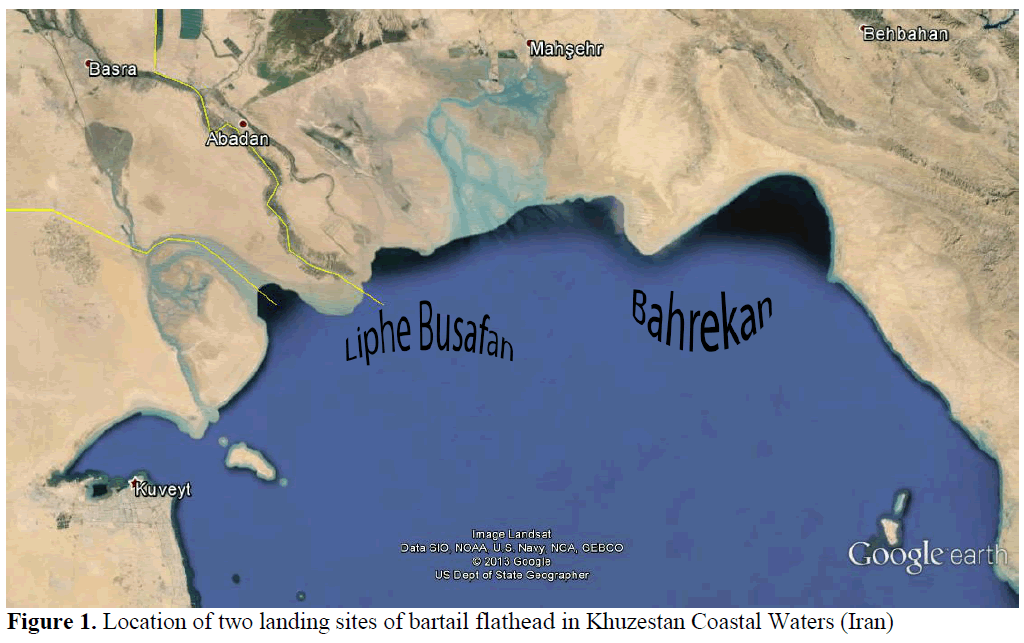
Figure 1: Location of two landing sites of bartail flathead in Khuzestan Coastal Waters (Iran)
Parameters of the length weight relationship were obtained by fitting the power function W = a x TLb to length and weight data where: W is the total wet weight, a is constant determined empiri-cally, TL is the total length (Biswas, 1993). In order to verify if calculated b was significantly different from 3, the t-test was employed (Zar, 1996).
The length frequency thus collected was grouped into 10 mm class intervals. The growth estimates were made by ELEFAN employing FiSAT II program developed by Gayanilo et al (2002). The total mortality coefficient was esti-mated by length converted catch curve of Pauly (1980):

Where, b=Z (Total mortality rate) with the sign changed. The instantaneous rate of natural mortality (M) was estimated using the following multiple regression model (Pauly, 1980):
Log (M) = -0.0066-0.279 log (L∞) +0.6543 log (K) + 0.4634 log (T)
The mean annual environment temperature (T) used in the estimation was 23° C (according to Iran Environment Public Authority). Fishing mortality rate (F) was calculated as (Sparre & Venema, 1998): F = Z - M.
The parameter t0 of the growth equation was estimated using the following equation (Pauly, 1980):
Log (t0) = -0.3922- 0.2752log (L∞) -1.038log (K)
In order to facilitate the comparison of the re-sults with those of other studies, growth perfor- mance index (Φ) was estimated by the following equation (Pauly and Munro, 1984):
Φ = log (K) +2Log (L∞)
The exploitation rate (U), was estimated by: U=F (1-e-z)/z (Pauly, 1983). The annual total stock at the beginning of the year was estimated by: Y/U where Y is the annual average catch of the species (Nurulamin et al., 2000). Annual av-erage standing stock was estimated by: b= Y/F (Nurulamin et al., 2000). MSY was estimated by the equation: MSY=0.5×Z×B (Nurulamin et al., 2002 and 2004).
MCY was estimated by the equation: MCY=2/3 × MSY (Jenning et al., 2000). The rel-ative yield per recruit (Y'/R) and relative biomass per recruit (B'/R) were conducted to obtain refer-ence points and determined the exploitation sta-tus. The model of Pauly and Soriano (1986) was used to predict the relative yield per recruit (Y/R) as follows:
Y'/R = EUM/k [1–(3U/1+m) + (3U2/1+2m) + (U3/1+3m)]
where: m = (1 – E)/ (M/k) = k/Z, U = 1 – (Lc/ L∞), E = F/Z and B'/R = (Y'/R)/F (Gayanilo et al., 2003). The relative biomass per recruit (B'/R) was estimated by: B'/R= (Y'/R)/F (Gayanilo et al., 2003).
Results and Discussion
Length frequency distribution
From the total number of caught fishes, 248 were males and the remaining were females (1: 0.92). According to Table 1, mean ±S.D length values for this species were 353±180 and maxi-mum and minimum total length was 57 mm and 1886 mm respectively. Mean ± S.D weight val-ues were 384±130g and maximum and minimum weight were 140 g and 600 g respectively (Table 1). Average length and weight in females were higher than in males.
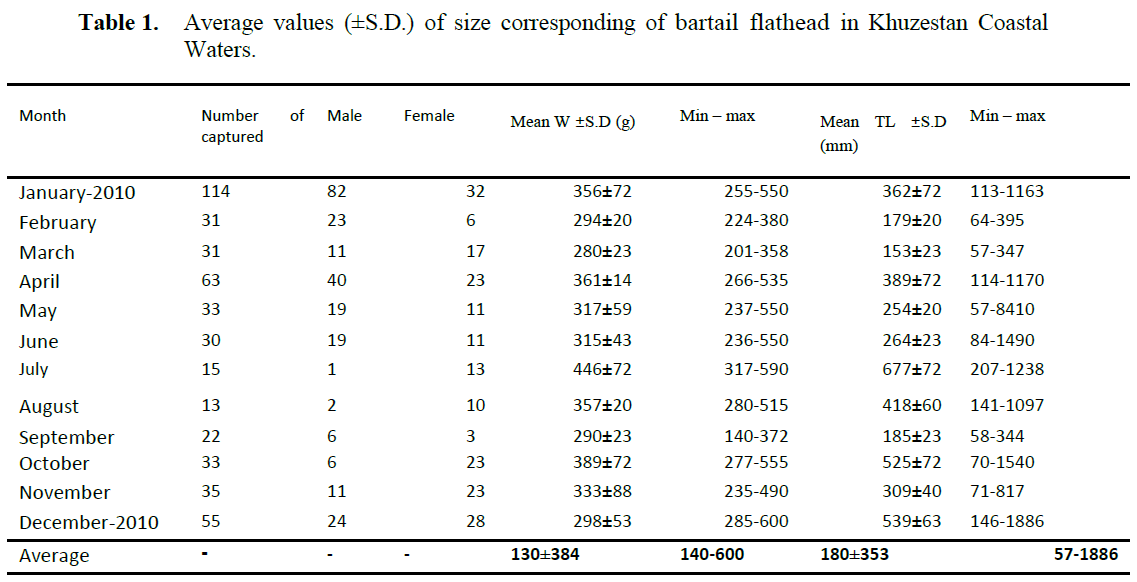
Table 1: Average values (±S.D.) of size corresponding of bartail flathead in Khuzestan Coastal Waters.
The length-weight relationship were calculat-ed as W=0.000009 TL2.95(n=248, R2=0.83) for males, W=0.000005TL3.07 (n=198, R2= 0.82) for females and W=0.000004TL3.10(n=470,R2 =0.86) for total fishes (Figure 2a,b). Verifying calculated b with 3, using t-test there was significant difference between calculated b and 3 (P<0.05).

Figure 2: Estimate growth, mortality and yield of bartail flathead in Khuzestan Coastal Waters.
Growth Studies
The growth parameters of von Bertalanffy equation (males and females combined) were as, L∞: 62.16 cm and K: 0.5 (year-1) and t0: -0.26 (year-1). The 95% confidence regions around the von Bertalanffy growth function parameter esti-mates for both sexes suggesting that the growth characteristics between males and females were not similar (Table 2, Figure 3a,b).
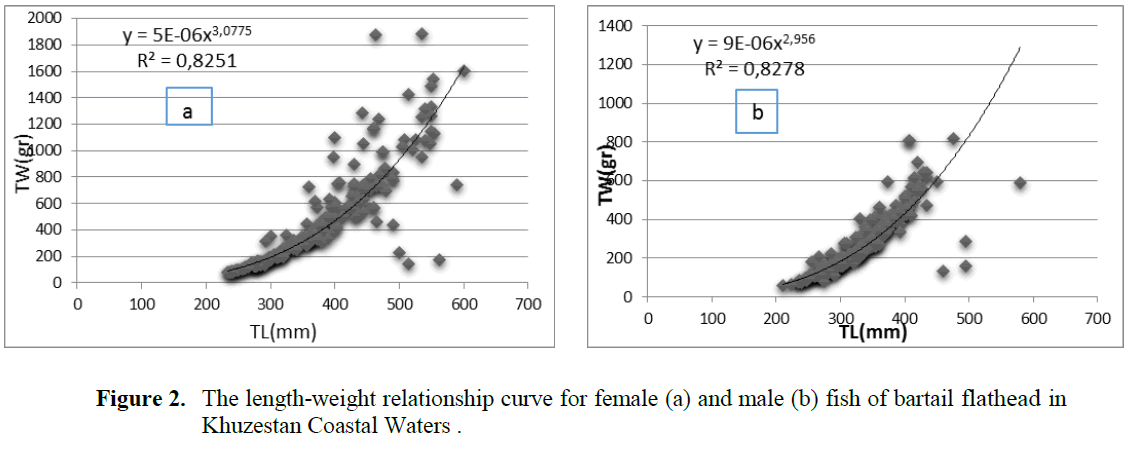
Table 2: The length-weight relationship curve for female (a) and male (b) fish of bartail flathead in Khuzestan Coastal Waters.
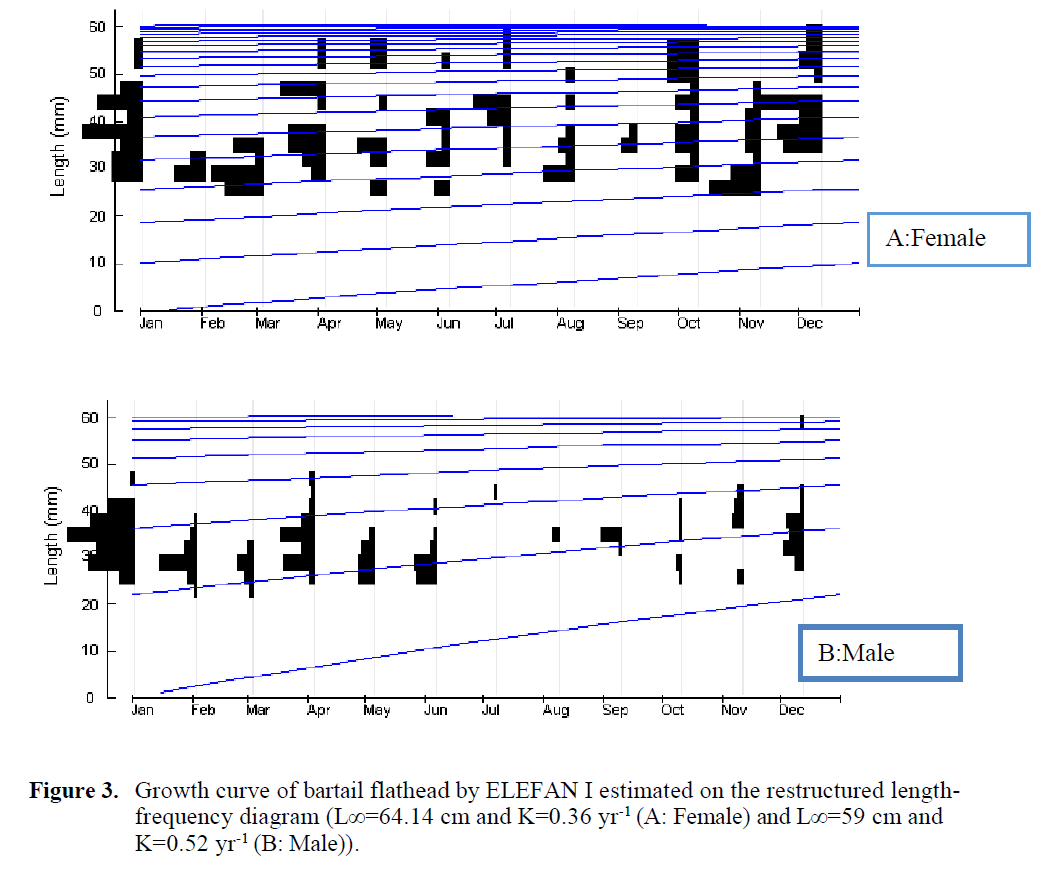
Figure 3: Growth curve of bartail flathead by ELEFAN I estimated on the restructured length-frequency diagram (L∞=64.14 cm and K=0.36 yr-1 (A: Female) and L∞=59 cm and K=0.52 yr-1 (B: Male)).
The value of growth performance index, Φ', estimated from the growth parameters was 1.19, which gave the Von Bertalanffy growth equation for this species as: Lt=62.16 (1-exp(-0.5 (t+0.26))). The Φ' for males and females studied fishes were found to be 0.91, 1.2 respectively (Table, 2).
Mortality estimate, relatively yield, relative biomass per recruit:
The annual instantaneous rates of fishing in-duced mortality (F), natural mortality (M) and total mortality (Z) are given in Table 2.
The total mortality coefficient (Z) was calculated as 2.59 year-1 by Pauly’s length converted catch curve method (Figure 4). The annual mortality coefficient (M) was estimated as 0.77 year-1 by Pauly’s method. The fishing mortality (F), thus obtaiend was 1.82 year-1. the exploration rate was calculated as 0.70.
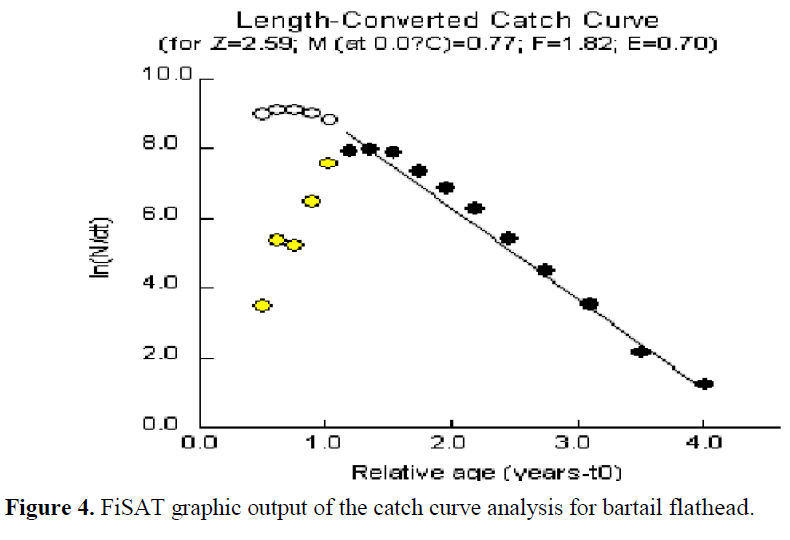
Figure 4: FiSAT graphic output of the catch curve analysis for bartail flathead.
Fishery Assessment
The relative yield-per-recruit (Y'/R) and bio-mass-per-recruit (B'/R) were determined as a function of Lc/L∞ and M/K. Lc estimated at 17.5 cm and and Lc/ L∞ and M/K were 0.27 and 1.54 respectively. Relative yield per recruitment (Y'/R) calculated as 0.019 and relative biomass per recruitment, (B'/R) calculated as 0.10 for bartail flathead using both sex data (Figure.5). The Y'/R and B'/R for males and females is shown in Table 2. The size at which yield per recruit would be maximized (Lmax = 29.1 cm) approximated the mean size of fish that were 0.99 years old and was considerably greater than the mean size at first capture.
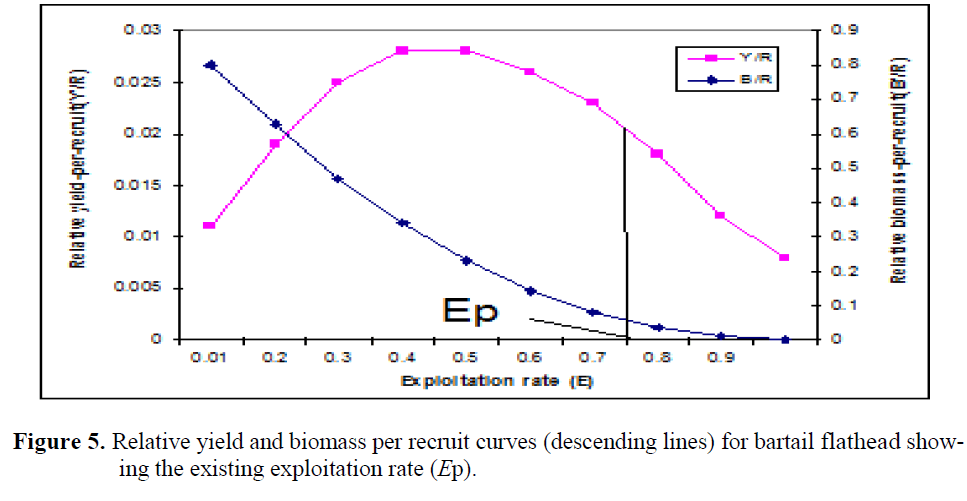
Figure 5: Relative yield and biomass per recruit curves (descending lines) for bartail flathead show-ing the existing exploitation rate (Ep).
Exploitation rate and annual total stock at be-ginning of year were calculated as 0.64 and 1194 respectively. T and Annual average standing stock, b: 420 T, MSY= 544 T and MCY=362 T were estimated respectively.
Perhaps, the earliest report on the growth study of P. indicus from the Persian Gulf is by Bawazeer (1989). He employed ELEFAN meth-od and estimated the infinity length and K as 48.90 cm and 0.34 y-1 in Kuwait waters respec-tively. In the present study L∞ and K was higher infinity length and growth coefficient which was reported by Bawazeer (1989). There are no avail-able growth data from other studies for P. indi-cus in the studied area. The ages of flathead (Platycephalus indicus; Japanese name: Mago-chi) were (fitted to the von Bertalanffy growth equations) Lt=430.3 (1−exp(−0.667 (t+0.093))) for males, and Lt=551.5 (1−exp(−0.478 (t+0.125))) for females(Masuda et al., 2000).
Tirasin (1993), indicated that growth parame-ters differed depending on species, population, age groups in the same population and even sexes. So the differences seen in different loca-tions may be accepted as normal.
Maximum age (Tmax) for male and female was found to be as 8.335 and 5.76 year respectively. Our results indicated that males have revealed higher growth condition and have short lifetime than female. Absorbed energy is used for body maintenance, activity, reproduction and less than 1/3 for growth. In difference species growth ratio and life cycle is different (King, 2007).
Bawazeer (1989) reported Age at zero length (t0) of this species as calculated as -0.64 year which less than our result (-0.26). Negative t0 values indicated juveniles grew more quickly than the predicted growth curve for adults (King, 2007). Values of Φ' for P. indicus has 2.91 in Kuwait waters (Bawazeer, 1989) which compere with present study show the high growth perfor-mance value.
The b values in the weight-length relationship were measured close to 3 for p. indicus fishes that indicating that weight increased isometric with length (King, 2007). Naik et al (1990) have estimated the value of b for Indian waters (the Netravati Gurpur Estuary, Mangalore) 2.99 and 2.91 for male and female respectively. Bawazeer (1989) reported the b value of weight-length was 3.32 for total fish of this species in Kuwait wa-ters. The variation of b in the different regions could be by seasonal fluctuations in environmen-tal parameters, physiological conditions of the fish at the time of collection, sex, gonad devel-opment and nutritive conditions in the environ-ment of fish (Biswas, 1993).
The result of exploration ratio revealed that there is Pressure on stock of this species in northwest waters of Persian Gulf side. According to Gulland (1971, 1979), the yield is optimized when F=M. These results are important for fish-eries management authorities as they suggest that the resource is heavily overexploited and in addi-tion to a revision of mesh size regulations, a sub-stantial reduction in fishing effort would also be required if management objectives are to be achieved (Hashemi and Kashi, 2012).
Result in this study showed exploitation ratio the bartail flathead stock is lower MSY and higher MCY. Increase in the size at first capture would be associated with an increase in yield at the existing fishing mortality rate. However, the existing fishing mortality rate (1.82 year−1) was greater than that which would maximize yield per recruit, clearly demonstrate that growth over fish-ing is occurring for this species. The relative bi-omass per recruit at the estimated fishing mortali-ty rate was particularly low at less than 15% of the unexploited level. If the critical spawning stock biomass is between 20 and 50% of the un-exploited level, as suggested by King (2007), re-cruitment over fishing is also likely to be occur-ring for P. indicus. In conclusion, any increase in the existing fishing level/exploitation would most likely result in a reduction in the yield per recruit and thereby hamper the optimum level. It is necessary to immediately impose fishing regu-lation on the stock.
Acknowledgements
The present study was carried out within the framework of the research project “Determina-tion of the ecological relationship among eco-nomic fishes in the coastal area of the Persian Gulf” funded by Iranian Fisheries Research Or-ganization (IFRO) and Iran National Science Foundation. Special thanks for presentation of material and spiritual supportive aids and ser-vices for this national project and all colleagues that helped during field work.
266
References
- nBawazeer, A.S., (1989). The stock and fishery biology of Indian flathead (wahar) Platyce-pahlus indicus (Linnaeus), family Platycep-halidae in Kuwait waters, Kuwait Bullten Marine Science, 10: 169-178
- nBiswas, S.P., (1993). Manuel of methods in fish biology, fish biology & Ecology laboratory, Dibruyarh University, Dibrugarh. pp157
- nGayanilo, F.C., Soriano, P., Pauly, D., (1996). The FAO-ICLARM Stock Assessment To-ols (FiSAT) Users guide. FAO Computeri-sed In formation Series (Fisheries), No. 8. Rome, FAO, 266p
- nGayanilo, F. C., Pauly, D., Parre, P., (2002). The FAO-ICLARM Stock assessment Tool (Fi-SAT) users guide. Rome. ITALY. pp 230
- nGulland, J.A., (1971). The fish resources of the ocean.west byfleet survey. Fishing News books Ltd., for FAO:255 p.Revised edition of FAO Fish.Tech. pap. (97):425p
- nGulland, J.A., (1979). Report of FAO/IOP workshop on the fishery resources of the western Indian Ocean South of the Equator. Rome, FAO, IOFC/DEV/79/45: 1-37
- nJenning, S. Kasier, M., Reynold, J., (2000). Ma-rine Fisheries Ecology. Black well Science. pp 391
- nHashemi, S., Kashi, M., (2012). Population Biol-ogy and Assessment of Southern Meagre (Argyrosomus hololepidotus) in Coastal Wa-ters (Persian Gulf), American-Eurasian Journal of Agricultural &Envi-ronmental Sciences, 12(10): 1329-1334
- nKing, M., (2007). Fisheries biology & assessment and management. Fishing news press, pp 340
- nMartine, W.R., (1949). The mechanics of envi-ronmental control of body form in fishes, University Toronto stud. Bio I., 58:1-91
- nMasuda, Y., Ozawa, T., Onoue, O., Hamada. T., (2000). Age and growth of the Flathead, Platycephalus indicus, from the coastal waters of west Kyushu, Japan, Fisheries Re-search, 46: 113-121. doi: 10.1016/S0165-7836(00)00138-7
- nMohammadi, G.H., Gholami R., Alvi, A., Mog-hamesi, S., Ofipor, M., (2011).Study of so-me biological characteristics of economical fishes (Tiger tooth Croacher, Silver pomfert, Yellow fin sea bream, Hilsa shad, Indo-pacific king mackerel, Narrow-barred Spa-nish,…) in the coastal waters of the Persian Gulf South of Iran aquaculture fishery rese-arch center, Ahwaz. Iran. p. 124
- nNaik, S.K., Shanbhogue, S.L., Jayabalan, N., Krishna-Bhat, C., (1990). Observations on Platycephalus indicus from the Netravati Gurpur Estuary, Mangalore, Environment and Ecology, 8(4): 1311-1313
- nNasir, N.A., (2000). The food and feeding relati-onships of the fish communities in the insho-re waters of Khor Al-Zubair, Northwest Arabian Gulf, Cybium, 24(1): 89-99
- nNurulamin, S.M., Rahman, M.A., Hadler, G.C., Mazid, M.A., Milton, D.A, Blaber S.J.M., (2002). Population Dynamics and Stock as-sessment of Hilsa shad, Tenualosa ilisha in Bangladesh, Asia Fisheris Science, 15: 123-128
- nNurulamin, S.M., Rahman, M.A., Hadler, G.C., Mazid, M.A., Milton, D.A., Blaber, S.J.M., (2004). Stock assessment and Management of Tenualosa ilisha in Bangladesh. Asia Fis-heris Science, 17: 50-59
- nParsamansh, A. Shalbaf, M. Eskandari, Gh. Kash, M., (2000).Survey fish stock assessment in Khuzestan province, South of Iran aquaculture fishery research center, Ahwaz. Iran. p. 69
- nPauly, D., (1980). On the inter-relationships between natural mortality, growth perfor-mance and mean environmental temperature in 175 fish stock. Journal du Conseil, 39(3): 175-192.doi: 10.1093/icesjms/39.2.175
- nPauly, D., (1983). Length-converted catch cur-ves: a powerful tool for fisheries research in the tropics (part 1), Fishbullten, 1(2): 9-13
- nPauly, D., Munro, J.L., (1984). Once more, on the composition of growth in fish and in ver-tebrates, Fishbullten, 2(1): 21-25
- nPauly, D., Soriano, M.L., (1986). Some practical extensions to Beverton and Holt’s relative-ield-per-recruit model. In The First Asian Fisheries Forum, pp. 491e496. Ed. by J. L. Maclean, L. B. Dizon, and L. V. Hosillo. Asian Fisheries Society, Manila. 727 pp
- nSmith, M., Heemstra, P.C., (1986). Smith's Sea Fishes. Springer Velage, Berlin Heidelberg, New York, London, Paris, Tokyo, pp: 1047. doi: 10.1007/978-3-642-82858-4
- nSparre, P., Venema, S.C., (1998). Introduction to tropical fish stock assessment, FAO Fishe-ries technical paper, Roma, 450 pp
- nTirasin, M., (1993). The studies on growth pa-rameters of fish population (in Turkish), The Scientific and Technical Research Council of Turkey, Journal of Zoology, C. 29: 29-82
- nWu, R.S., (1984). The feeding habits of seven demersal fish species in a subtropical estu-ary, Asian Marine Biology, 1: 17-26
- nZar, J.H., (1996). Biostatistical analysis. 3rd edi-tion. Prentice-Hall Inc., New Jersey, USA. 662P.














